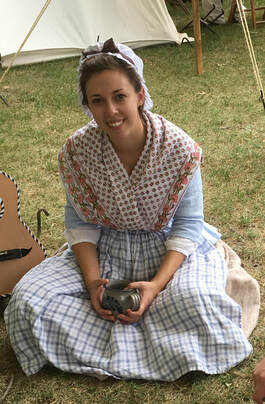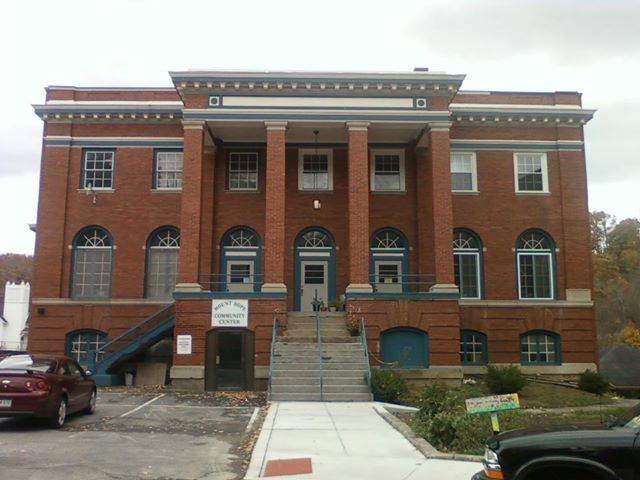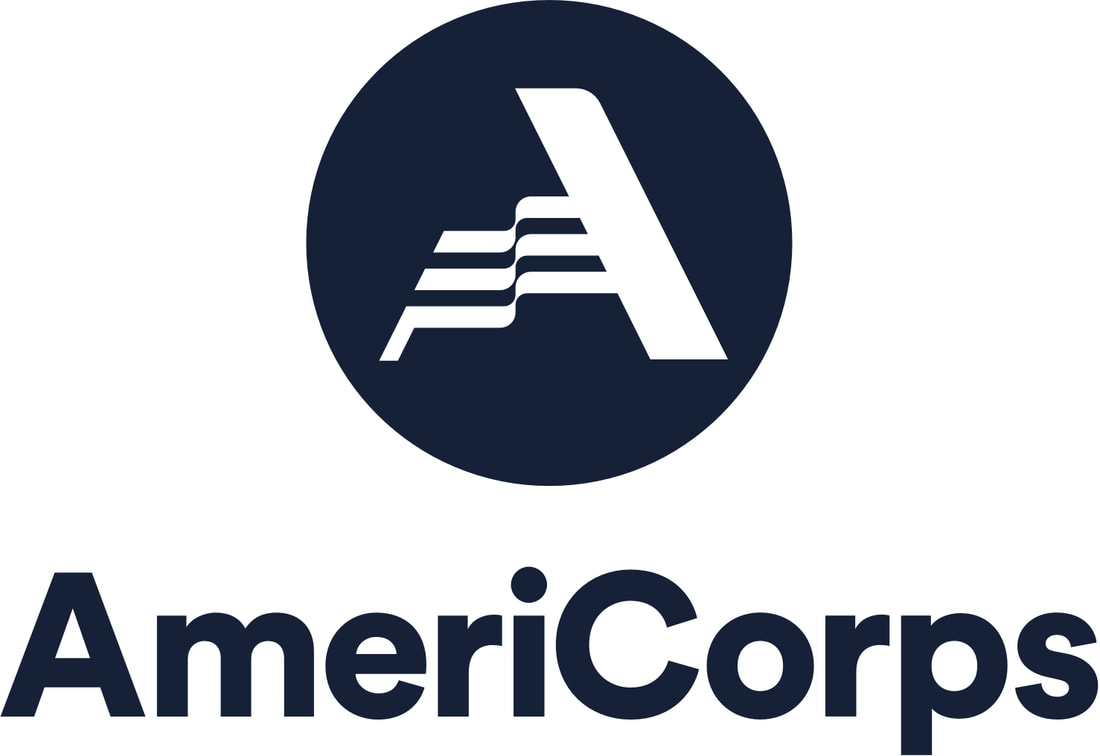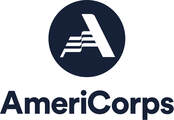 My name is Kara Gordon and I am a Preserve WV AmeriCorps Member at the Cockayne Farmstead in Glen Dale, WV. Since I am originally from Wheeling, WV, I love that I get to help preserve the history of my own local area. So far, I have stayed relatively local pretty much my whole life, graduating with a bachelor’s degree in history from Wheeling Jesuit University and a master’s degree in history from West Virginia University. While in school, I also worked, volunteered, or interned at several museums and archives, including the Archives of the Diocese of Wheeling-Charleston, the Mansion Museum at Oglebay Institute, and the West Virginia and Regional History Center. I love studying everyday history in many forms, but I am especially interested in material culture, and most especially, clothing and textiles. In the summer of 2017, I got the opportunity to intern at Colonial Williamsburg in the Margaret Hunter Millinery Shop and it was truly a dream come true! I love to sew and recreating historical garments has been a favorite hobby of mine for many years. When you try on the clothing worn by people from another time – literally stepping into their shoes – I feel like that connection to the past becomes even more real. Cockayne Farmstead is a bit of a diamond in the rough in many ways. The house itself is rough inside, since it has been preserved but not restored, left as it was found by its last, reclusive owner. Sometimes the “shabby” appearance shocks visitors at first, but it is a glimpse into the passage of time that simply takes a little bit of time to appreciate. Like so many small, volunteer-led historic sites, the house only exists at all because of passionate, dedicated individuals working with very limited resources. This is the story for so many small sites in West Virginia and across the country, and serving with AmeriCorps allows me to help preserve this important local resource. Though its smallness may seem like a disadvantage to some, I look forward to taking on the greater challenges and responsibilities that come with working in a place where my ideas and actions can truly make a difference, instead of being lost in the crowd. It’s a place and a story you can truly become attached to, and I look forward to serving here for the coming year.  Architecture, at its best, creates an environment that is both functional and beautiful. In a world devoid of any concern for aesthetics, we lose our ability to revel in the beauty that surrounds us, confounds us, and inspires us. I spend a lot of my time looking up and around, enjoying the built and natural environment. This is how I’ve come to know that Wheeling, WV is the right place for me. If you’ve never visited Wheeling, you’re missing out on an architectural gem. Throughout my time in the Friendly City, I have never lived in any building younger than 100 years old. My name is Kellie White, and I am a historic preservationist in training. I am originally from Virginia Beach, VA. I moved to Fairfax, VA in 2012 to pursue my undergraduate degree at George Mason University. I completed my BA in Art History and Anthropology with a minor in Women and Gender Studies in 2016. After I graduated, in the Fall of 2016, I decided to move to Wheeling and attend Belmont College to study Building Preservation. Except I didn’t always want to study historic preservation; it took me a while to reach that decision! During middle and high school I was a dedicated musician, and I wholeheartedly believed I would study music. And yet I entered college as an Environmental Studies major. In retrospect, I see that I started down this path in high school. Mrs. Reich’s AP Art History was the most influential class I took in high school; it eventually lead me to study a combination of Art History and Anthropology in college. And Art History lead to the greatest summer of my life. During the summer of 2014, I was offered to opportunity to study archaeology and preservation at George Washington’s Mt. Vernon. I spent that time smeared in dirt and happier than I could have imagined. There’s something mesmerizing about interacting with history in such a gritty, substantial way. That summer was decisive in determining the path I have traveled for the past 2 years. That summer is when I learned about Belmont College and its hands-on Building Preservation program; it planted the seed for where I am now. In my current Plaster course, I am learning to “run” a cornice and cast the decorative elements in plaster. I currently attend Belmont College studying Building Preservation, and I am immersed in the Wheeling community. I am a board member of the Wheeling Young Preservationist, a group of like-minded individuals who take stock of preservation activities and needs within our community. I am also a member of the Wheeling Arts and Cultural Commision; we help encourage creativity in Wheeling. I take pride in my community, in our community. I want to see tangible change in Wheeling, in the whole of West Virginia. This is why I’ve chosen to serve as the Americorps member for the West Virginia Association of Museums. By preserving and educating others about our communal heritage, I hope to help us all recognize the humanity we share. Museums are a space to explore this cultural inheritance.. Standing in a museum, examining a display, for a moment we are sharing an experience. We are all being presented the same information, being confronted with the same truths, being shown our heritage and history. Have you ever experienced wonder or delight in a museum, standing in front of a painting, a historic flag, or a suit of armor? I have. I hope that feeling never fades. Through my service at the West Virginia Association of Museums, I aim to encourage people to visit museums, to experience that wonder, and to bond over our communal heritage. By Pamela Curtin
According to Greek mythology, Clio was the muse of history, one of a number of muses who protected the arts and sciences. It follows that a modern website and mobile app named Clio would have strong ties to the arts. As an AmeriCorps member with Clio, a nonprofit digital platform that connects the public to historic and cultural sites, I have had the pleasure of working with arts organizations to share public works of art, galleries, and studios. Last year, I worked with Sally Deskins, Exhibits and Programs Coordinator at WVU Libraries, to create a Clio tour of Morgantown art. Sally has helped turn WVU’s extensive library system into showcases for art. With her leadership, WVU Libraries hosts art exhibits featuring modern and historic photography, paintings, and multimedia pieces, often focusing on West Virginia and Appalachia. This spring, Sally received a Grant for Community Engagement from the WVU Research Office to create a public art guide of Morgantown. In addition to a printed guide, Sally was interested in creating a digital version that would be accessible online. This is where Clio enters the story. Clio lends itself well to collaborative projects. Anyone can find historic and cultural sites in their area that would contribute to Clio’s growing database. It is easy to make contributions to the website – no different than filling out an online form – which helps users like museums and students devote their time to doing research and writing. As a free platform, Clio allows grantees to put funds toward scholars, student interns, or printed materials. Clio entries and tours can also be integrated with exhibits, programs, and printed walking tours. Earlier this year, I created Clio tours as part of a WVU Libraries photography exhibit on Sunnyside, a historic neighborhood in Morgantown. I was excited when Sally reached out about using Clio to create a digital Morgantown Public Art Guide. There are more than thirty public works of art around Morgantown created by everyone from student volunteers to world-renowned professionals. A number of these works, however, have no accompanying label or significant online presence. With print and digital guides, we could document and better engage the public with art in their backyard. Sally said of this endeavor, “By first digging deeper into the historical context of the sites and works, we really understand more fully the significance of each work individually, and of this project as a whole.” Each work of art, along with local arts institutions, received a Clio entry. The Clio entry includes a narrative, images, sources, links to related content, and a pin connected to GPS coordinates. If you are in Morgantown, Clio’s website and mobile app will pick up your location and show the entries closest to you; or, you can simply search “Morgantown, WV” from anywhere in the country and the entries will appear. These entries are then strung together in a digital tour that follows a route using Google Maps. We started developing entries in Clio’s flexible and collaborative platform. “Clio helped us visualize how the print guide might be organized and the tours arranged by seeing them on the map,” Sally explained. “It has served as a ‘home base’ for the project, where all of the information is organized nicely and we can see our progress. With limited resources, as well, Clio allowed us to do all of this for free! How amazing is that.” Works of art range from a sculptures of basketball players at the Coliseum to mosaics along the Rail Trail to murals curated by the Friends of Deckers Creek. The entries explore the history and artistic styles of these pieces, their development and placement in certain locations, and biographies of artists and project leaders. Sites like libraries and university buildings are also included on the tour, as many of them house indoor paintings, sculptures, murals, textiles, and rotating exhibits. A number of arts institutions including art centers, museums, galleries, and studios are identified along with a discussion of their respective history and mission. Clio entries can also link readers to ways to get involved with these organizations. Sally worked with student interns and volunteers to develop the Clio entries. “It has been a great experience for the several students working on the project as well as for myself,” she said. Other important collaborators include the Greater Morgantown Convention and Visitors Bureau, Arts Monongahela, the Art Museum of WVU and the College of Creative Arts. “Clio has been kind of like the back bone of the Morgantown Public Art Guide project,” Sally said. The print and digital versions of the Morgantown Public Art Guide are set to launch this fall. As an AmeriCorps member, it has been wonderful working with Sally on the Morgantown Public Art Guide. I am grateful that my AmeriCorps site could provide her with the tools to realize her vision for this project. AmeriCorps members serving with the Preservation Alliance of West Virginia will hold a Civic Service Project in honor of Dr. Martin Luther King Jr. at the Mount Hope Community Center on January 21st, 2019.
The primary goal for this service project, A Clean City Starts with You, is to remove unused equipment and debris from the community center in order to help prepare it for future use. The historic Loup Creek YMCA, now commonly known as the Mount Hope Community Center houses an operational commercial kitchen, a large conference space commonly referred to as the Band Room, and operates as a sports complex for 25% of the year. Other local nonprofits and organizations including Harmony For Hope, Dubois on Main, volunteers from West Virginia University, and Sarah Soup’s will be participating during the event as well. Projects will begin at 8am and will continue throughout the day. “As AmeriCorps members, our civic service projects often turn out to be some of our most significant projects during the service year. Through these projects we are able to connect with communities and local volunteers to come together and really make a difference.” explains co-organizer Kyle Bailey. If you are interested in volunteering for this event, contact Kyle Bailey at [email protected]. |
Preserve WV StoriesCategories
All
Archives
August 2023
|
Get Involved |
Programs |
Contact UsPreservation Alliance of West Virginia
421 Davis Avenue, #4 | Elkins, WV 26241 Email: [email protected] Phone: 304-345-6005 |
Organizational Partners:
© COPYRIGHT 2022 - PRESERVATION ALLIANCE OF WEST VIRGINIA. ALL RIGHTS RESERVED.



 RSS Feed
RSS Feed



